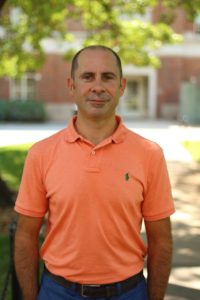Dr. Matteo Minghetti is an Assistant Professor in the Department of Integrative Biology at Oklahoma State University (OSU). Dr. Minghetti received his Ph.D. in Ecotoxicology from the University of Stirling, UK in 2009. His diverse postdoctoral work includes projects on the transcriptional regulation of lipid metabolism in Atlantic Salmon (University of Stirling), the use of primary gill cultures for environmental biomonitoring (Kings College London), and the mechanisms of toxicity of metal nanoparticles in intestinal fish cells (Eawag – The Swiss Federal Institute of Aquatic Science and Technology). Dr. Minghetti is a recipient of a Marie Curie Fellowship (2012) and a National Science Foundation award (2018). His research interests lie at the interface between disciplines integrating analytical chemistry, molecular biology and physiology. The Minghetti Lab at OSU focuses on understanding physiological processes such as essential trace element homeostasis and developing tools for environmental biomonitoring.
Read Matteo Minghetti’s Emerging Investigator Series article “Linking Chemical Transformations of Silver and Silver Nanoparticles in the Extracellular and Intracellular Environment to their Bio-reactivity” and read more about him in the interview below:
Your recent Emerging Investigator Series paper focuses on Linking Chemical Transformations of Silver and Silver Nanoparticles in the Extracellular and Intracellular Environment to their Bio-reactivity. How has your research evolved from your first article to this most recent article?
Mechanisms of cellular metal homeostasis and handling have been the main focus of my research so far. During my PhD, I discovered that fish, similarly to humans, take up and excrete copper using specific copper transport proteins (CBP 2008, 147(4):459-9; Aquat. Toxicol. 2010, 97(1):23-33). After my PhD, I began to consider the environmental factors that affect metal bioavailability such us metal complexation with ligands present in the extracellular medium and competition with other cations. To examine these concepts, I began to use in vitro models of the gill and intestinal epithelium. This research revealed that extracellular metal speciation is linked to metal bioavailability and toxicity, but also that intracellular accumulation is not always linked with bio-reactivity (i.e. metallothionein gene expression) (Nanotoxicology 2016, 10(10):1526-1534). It became clear to me, therefore, that establishing the link between extracellular and intracellular metal speciation was necessary to fully understand the environmental conditions that potentially lead to organismal metal bioavailability, bioreactivity and toxicity. Intracellular metal speciation detection requires the use of X-ray spectroscopy, a technique that has been used extensively in physics, chemistry and geology but its use in biology is relatively new. In order to access this technique, I started a collaboration with Professor Jeffrey Catalano (Washington University in St. Louis), a geochemist and expert in synchrotron-based X-ray spectroscopic methods. I believe that studies at the interface between disciplines lead to potentially transformative discoveries.
What aspect of your work are you most excited about at the moment?
I am particularly excited about my recent work with X-ray florescence microscopy, which I use to visualize intracellular endogenous elements in cells. After many years of indirectly measuring the effect of metals and nano-metals in cells through gene and protein expression, I have found it really fascinating to be able to actually visualize clusters of metal ions in the cell with my own eyes.
In your opinion, what are the most important questions to be asked/answered in this field of research?
Once a metal or metal nanoparticle enters a cell, its intracellular fate over time will determine cellular effects. For instance, a particle might remain unaltered and non-bioreactive in the cell or dissolve rapidly and induce a sharp biological response. While important discoveries have been made in the nanotoxicology field with regard to factors influencing nanoparticle uptake (e.g. particle size, coating and corona protein interactions, etc.), our understanding of the factors influencing intracellular fate and transformation of nanoparticles is still poorly understood.
What do you find most challenging about your research?
Although fish cell lines have proven to be a useful tool for toxicological studies, they lack the complexity of the “real” tissue. A new generation of in vitro models is necessary to mimic more closely the responses of the whole organism. Such new systems will need to include multiple cell types in a substrate that mimics the tissue microenvironment. The main challenge is that developing such new in vitro models requires a multi-disciplinary approach involving collaborations between biologists and engineers.
In which upcoming conferences or events may our readers meet you?
I will attend the SETAC North America meeting, which is in Toronto this year. I am excited to co-chair a session on Nanotoxicology at this meeting and I would welcome colleagues to participate in this session and discuss new discoveries in this exciting field.
How do you spend your spare time?
I love spending time outdoors. Since moving to the U.S., my family and I have fallen in love with the National Parks’ system and we try to visit as many as possible every year. I also enjoy cycling with my local cycling club. It is a great way to relax!
Which profession would you choose if you were not a scientist?
I love driving and visiting new and exciting places. Joking with my wife, I always say I would have been a good ice road trucker!
Can you share one piece of career-related advice or wisdom with other early career scientists?
As I’ve mentioned, I firmly believe that new discoveries lie at the interface between disciplines. So, I would encourage early career scientists to collaborate with researchers from other fields of science. I have always found it very informative and useful to attend seminars and meetings outside of my discipline. Other than that, follow your personal interest and passion and try not to be too influenced by current trends.











